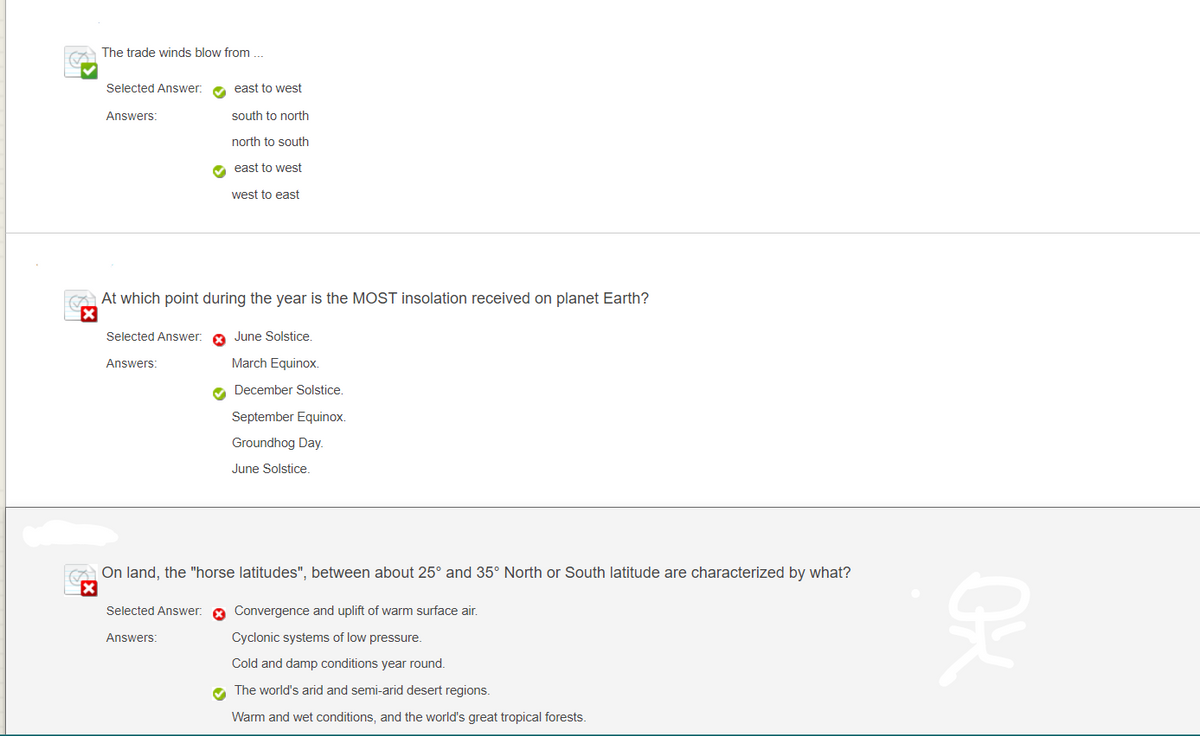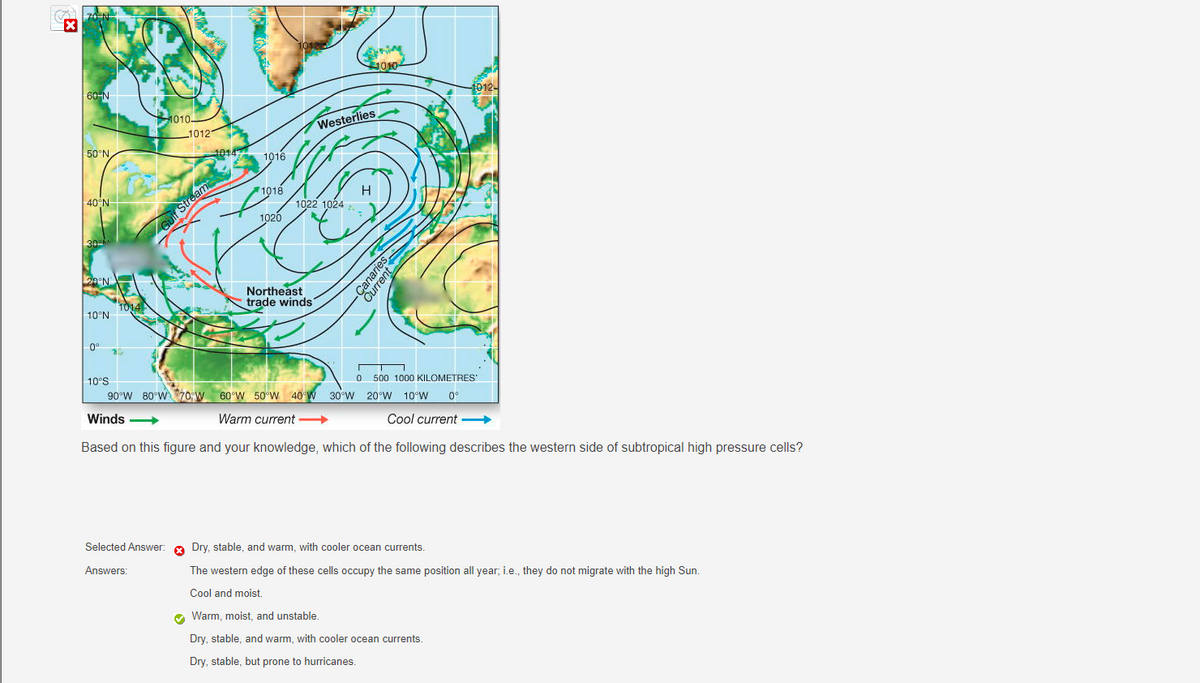A The trade winds blow from Selected Answer. e east to west Answers: south to north north to south O east to west west to east A At which point during the year is the MOST insolation received on planet Earth? Selected Answer. June Solstice. Answers: March Equinox. O December Solstice. September Equinox. Groundhog Day. June Solstice. A On land, the "horse latitudes", between about 25° and 35° North or South latitude are characterized by what? Selected Answer. a Convergence and uplift of warm surface air. Answers: Cyclonic systems of low pressure. Cold and damp conditions year round. e The world's arid and semi-arid desert regions. Warm and wet conditions, and the world's great tropical forests.
A The trade winds blow from Selected Answer. e east to west Answers: south to north north to south O east to west west to east A At which point during the year is the MOST insolation received on planet Earth? Selected Answer. June Solstice. Answers: March Equinox. O December Solstice. September Equinox. Groundhog Day. June Solstice. A On land, the "horse latitudes", between about 25° and 35° North or South latitude are characterized by what? Selected Answer. a Convergence and uplift of warm surface air. Answers: Cyclonic systems of low pressure. Cold and damp conditions year round. e The world's arid and semi-arid desert regions. Warm and wet conditions, and the world's great tropical forests.
Applications and Investigations in Earth Science (9th Edition)
9th Edition
ISBN:9780134746241
Author:Edward J. Tarbuck, Frederick K. Lutgens, Dennis G. Tasa
Publisher:Edward J. Tarbuck, Frederick K. Lutgens, Dennis G. Tasa
Chapter1: The Study Of Minerals
Section: Chapter Questions
Problem 1LR
Related questions
Question
earth science questions

Transcribed Image Text:cA The trade winds blow from
Selected Answer:
east to west
Answers:
south to north
north to south
O east to west
west to east
A At which point during the year is the MOST insolation received on planet Earth?
Selected Answer:
June Solstice.
Answers:
March Equinox.
December Solstice.
September Equinox.
Groundhog Day.
June Solstice.
A On land, the "horse latitudes", between about 25° and 35° North or South latitude are characterized by what?
Selected Answer: a Convergence and uplift of warm surface air.
Answers:
Cyclonic systems of low pressure.
Cold and damp conditions year round.
The world's arid and semi-arid desert regions.
Warm and wet conditions, and the world's great tropical forests.

Transcribed Image Text:70°N
010
1012-
60°N
1010-
1012
Westerlies
50°N
10147
1016
1018
40°N
1022 1024
1026
30°
Northeast
trade winds
10°N
0°
500 1000 KILOMETRES
10°S
90°W 80°W70:W 60°W 50°W 40
30°W 20°W 10°W
0°
Winds
Warm current
Cool current
Based on this figure and your knowledge, which of the following describes the western side of subtropical high pressure cells?
Selected Answer: a Dry, stable, and warm, with cooler ocean currents.
Answers:
The western edge of these cells occupy the same position all year; i.e., they do not migrate with the high Sun.
Cool and moist.
Warm, moist, and unstable.
Dry, stable, and warm, with cooler ocean currents.
Dry, stable, but prone to hurricanes.
aries
Expert Solution
This question has been solved!
Explore an expertly crafted, step-by-step solution for a thorough understanding of key concepts.
Step by step
Solved in 4 steps

Recommended textbooks for you

Applications and Investigations in Earth Science …
Earth Science
ISBN:
9780134746241
Author:
Edward J. Tarbuck, Frederick K. Lutgens, Dennis G. Tasa
Publisher:
PEARSON

Exercises for Weather & Climate (9th Edition)
Earth Science
ISBN:
9780134041360
Author:
Greg Carbone
Publisher:
PEARSON

Environmental Science
Earth Science
ISBN:
9781260153125
Author:
William P Cunningham Prof., Mary Ann Cunningham Professor
Publisher:
McGraw-Hill Education

Applications and Investigations in Earth Science …
Earth Science
ISBN:
9780134746241
Author:
Edward J. Tarbuck, Frederick K. Lutgens, Dennis G. Tasa
Publisher:
PEARSON

Exercises for Weather & Climate (9th Edition)
Earth Science
ISBN:
9780134041360
Author:
Greg Carbone
Publisher:
PEARSON

Environmental Science
Earth Science
ISBN:
9781260153125
Author:
William P Cunningham Prof., Mary Ann Cunningham Professor
Publisher:
McGraw-Hill Education

Earth Science (15th Edition)
Earth Science
ISBN:
9780134543536
Author:
Edward J. Tarbuck, Frederick K. Lutgens, Dennis G. Tasa
Publisher:
PEARSON

Environmental Science (MindTap Course List)
Earth Science
ISBN:
9781337569613
Author:
G. Tyler Miller, Scott Spoolman
Publisher:
Cengage Learning

Physical Geology
Earth Science
ISBN:
9781259916823
Author:
Plummer, Charles C., CARLSON, Diane H., Hammersley, Lisa
Publisher:
Mcgraw-hill Education,